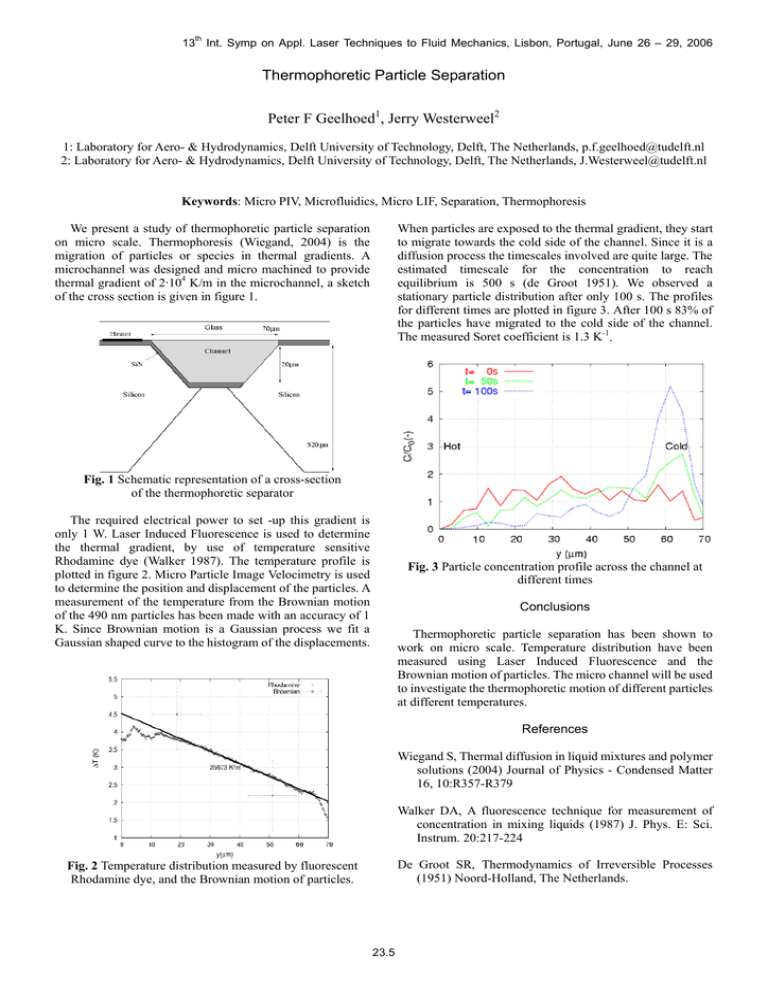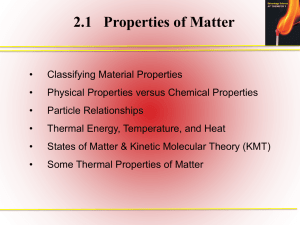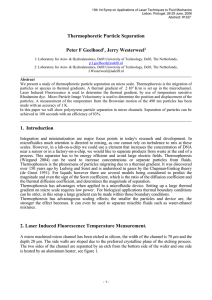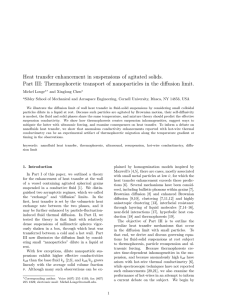Thermophoretic Particle Separation Peter F Geelhoed , Jerry Westerweel
advertisement

13th Int. Symp on Appl. Laser Techniques to Fluid Mechanics, Lisbon, Portugal, June 26 – 29, 2006 Thermophoretic Particle Separation Peter F Geelhoed1, Jerry Westerweel2 1: Laboratory for Aero- & Hydrodynamics, Delft University of Technology, Delft, The Netherlands, p.f.geelhoed@tudelft.nl 2: Laboratory for Aero- & Hydrodynamics, Delft University of Technology, Delft, The Netherlands, J.Westerweel@tudelft.nl Keywords: Micro PIV, Microfluidics, Micro LIF, Separation, Thermophoresis We present a study of thermophoretic particle separation on micro scale. Thermophoresis (Wiegand, 2004) is the migration of particles or species in thermal gradients. A microchannel was designed and micro machined to provide thermal gradient of 2·104 K/m in the microchannel, a sketch of the cross section is given in figure 1. When particles are exposed to the thermal gradient, they start to migrate towards the cold side of the channel. Since it is a diffusion process the timescales involved are quite large. The estimated timescale for the concentration to reach equilibrium is 500 s (de Groot 1951). We observed a stationary particle distribution after only 100 s. The profiles for different times are plotted in figure 3. After 100 s 83% of the particles have migrated to the cold side of the channel. The measured Soret coefficient is 1.3 K-1. Fig. 1 Schematic representation of a cross-section of the thermophoretic separator The required electrical power to set -up this gradient is only 1 W. Laser Induced Fluorescence is used to determine the thermal gradient, by use of temperature sensitive Rhodamine dye (Walker 1987). The temperature profile is plotted in figure 2. Micro Particle Image Velocimetry is used to determine the position and displacement of the particles. A measurement of the temperature from the Brownian motion of the 490 nm particles has been made with an accuracy of 1 K. Since Brownian motion is a Gaussian process we fit a Gaussian shaped curve to the histogram of the displacements. Fig. 3 Particle concentration profile across the channel at different times Conclusions Thermophoretic particle separation has been shown to work on micro scale. Temperature distribution have been measured using Laser Induced Fluorescence and the Brownian motion of particles. The micro channel will be used to investigate the thermophoretic motion of different particles at different temperatures. References Wiegand S, Thermal diffusion in liquid mixtures and polymer solutions (2004) Journal of Physics - Condensed Matter 16, 10:R357-R379 Walker DA, A fluorescence technique for measurement of concentration in mixing liquids (1987) J. Phys. E: Sci. Instrum. 20:217-224 De Groot SR, Thermodynamics of Irreversible Processes (1951) Noord-Holland, The Netherlands. Fig. 2 Temperature distribution measured by fluorescent Rhodamine dye, and the Brownian motion of particles. 23.5








